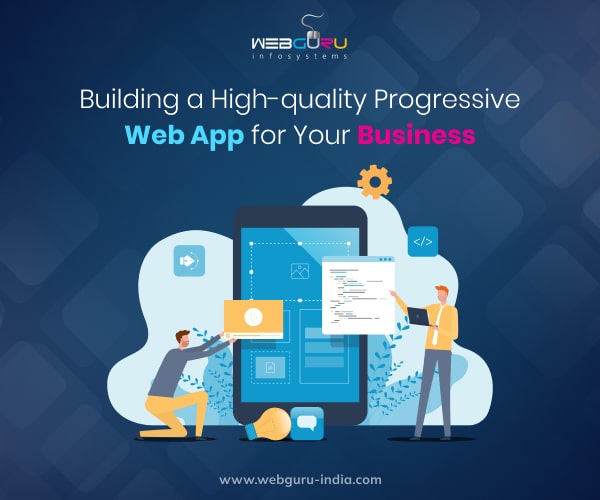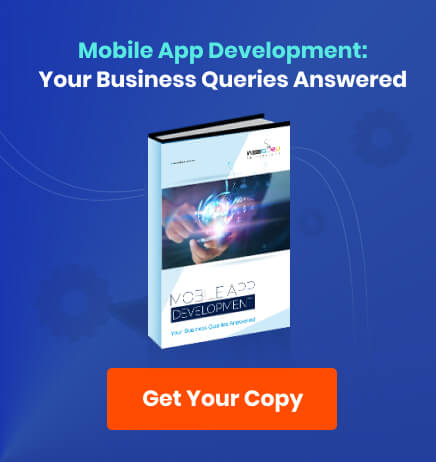Home Blog Website Development Building a High-quality Progressive Web App for Your Business
Building a High-quality Progressive Web App for Your Business
- 12 Sep / 2023
- 6,593 views
- 7 Min Read

Web applications allow users to perform tasks in the browser that are comparable to those performed in native apps, and mobile devices now make up more than half of all traffic on the internet. However, there is a problem: connectivity and device quality throughout the world vary greatly.
The newest usability challenge for any website development company is serving both users in rural India with antiquated phones, as well as, users in Seoul with lightning-fast connections. Progressive Web Apps are the answer in this case.
PWAs employ progressive enhancement to load the most crucial material first, adding presentational and functional additions as necessary to ensure that all of your users get the same core experience as rapidly as feasible. PWAs are the best option if you want to reach the largest audience possible.
What are the benefits of PWAs?
PWAs have some distinct advantages:
• Improved User Experience: PWAs load fast and provide a smooth, app-like experience to users.
• Enhanced Performance: Service Workers, a core progressive web application component, enable offline functionality and faster loading times.
• Cost-Effectiveness: They are less resource-intensive to develop and maintain compared to native apps.
• Accessibility and Cross-Platform Compatibility: PWAs work on various devices and browsers, making them accessible to a wider audience.
Successful PWA Examples
To illustrate the power of PWAs, let’s look at a few real-world examples:
• Twitter Lite: Twitter reduced data usage by 70% with their PWA, improving user engagement in low-network areas.
• Flipkart: The e-commerce giant saw a 70% increase in conversions after launching their PWA.
Planning Your PWA: The First Steps Toward Success
Identifying Your Business Goals
Before diving into PWA development, it’s crucial to define your objectives:
• Boosting User Engagement: Are you looking to increase user interaction with your content or services?
• Increasing Conversion Rates: Do you want to improve the percentage of visitors who become customers?
• Expanding Your Customer Base: Is your goal to reach a broader audience?
Defining Your Target Audience
Understanding your audience’s preferences and behavior is key:
• User Behavior Analysis: Study your users’ habits and expectations regarding your online presence.
Setting a Budget and Timeline
Building a PWA can be cost-effective, but you still need to plan:
• Cost Considerations: Your overall costs can include design, development, testing, and maintenance costs.
• Development Timeframe: Make an educated estimation of how long it will take to take the app from concept to launch. Talking to experts from a reputed website development company can give you a clear idea about estimated time requirements.
Key Components of a PWA: Building Blocks of Success
Service Workers: The Heart of a PWA
Service workers are scripts that run in the background, enabling features like offline access:
• Offline Functionality: Service workers allow your PWA to work even when the user is offline.
App Shell and User Interface
A well-designed app shell is essential:
• Responsive Design: Ensure your PWA looks great on all devices.
Web App Manifest
This JSON file defines your app’s appearance and behavior:
• Key Properties: Specify the app’s name, icons, and start URL in the manifest
HTTPS and Security
Security is paramount for a successful PWA
• Importance of HTTPS: Secure your PWA with HTTPS to protect user data.
Developing Your PWA: Building the Foundation
Technology Stack
Choosing the right tech stack is vital:
• Frontend Technologies: Select frameworks and libraries that suit your project.
• Backend Considerations: Ensure your server can handle PWA requirements.
Coding and Development
Let’s get technical:
• Setting Up Your Environment: Prepare your development tools and environment.
• Writing Service Workers: Create scripts that control caching and background sync.
• Implementing Responsive Design: Design for various screen sizes and orientations.
Testing and Debugging
Ensure a smooth user experience:
• Testing on Different Devices and Browsers: Cover all bases to avoid unexpected issues.
• Debugging Common PWA Issues: Address common problems like caching and service worker conflicts.
Making Your PWA Installable: Encouraging Users to Stay
Promoting Installation
Get users to add your PWA to their home screens:
• Browser Prompts: Use built-in browser features to prompt users to install.
Offline Capabilities
Keep your PWA functional without an internet connection:
• Caching Strategies: Implement caching to store essential assets.
• Background Sync: Ensure data updates seamlessly when the user is online again.
App Store Submission
Consider distributing your PWA through app stores:
• Options for Distribution: Explore the pros and cons of app store submission.
• Submission Process and Requirements: Understand the submission process.
Optimizing Performance: Keeping Users Happy
Performance Metrics
Measure what matters:
• Key Performance Indicators: Focus on metrics like load time, time to interactive, and first contentful paint.
Progressive Enhancement
Ensure your PWA works for everyone:
• Graceful Degradation: Make sure your PWA functions even in less capable browsers.
Minimizing Load Times
Speed is of the essence:
• Compress Assets and Images: Reduce the size of your files for quicker loading.
• Reducing Server Requests: Minimize the number of requests your PWA makes to the server.
Continuous Monitoring
Don’t stop improving:
• Tools for Ongoing Optimization: Use performance monitoring tools such as React and LambdaTest to track your PWA’s performance.
Testing and Quality Assurance: Ensuring a Smooth User Experience
Cross-Browser Compatibility
Don’t leave any user behind:
• Testing on Various Browsers and Versions: Ensure your PWA functions on all major browsers.
User Testing
Gather real-world feedback:
• Gathering Feedback: Let real users test your PWA and provide input.
Performance Testing
Prepare for heavy traffic:
• Load Testing: Ensure your PWA can handle high loads and traffic spikes.
Launching Your PWA: Taking It Live
Pre-Launch Checklist
Ensure everything is in order:
• Final Testing: Thoroughly test your PWA before launch.
• Preparing Promotional Materials: Create marketing materials to promote your PWA.
Deployment Strategies
Roll out your PWA strategically:
• Rolling Out Your PWA: Gradually release your PWA to avoid overwhelming your servers.
• Handling Updates and Maintenance: Plan for regular updates and maintenance.
Measuring Success: Tracking Your PWA’s Performance
Analytics and Monitoring
Stay informed about your PWA’s performance:
• Tracking User Engagement and Conversions: Measure how users interact with your PWA.
• Analyzing Performance Metrics: Keep an eye on key metrics to identify areas for improvement.
Iteration and Improvement
Use data to your advantage:
• Using Data to Make Informed Updates: Make data-driven decisions to improve your PWA.
• Feedback Loops: Encourage users to provide feedback and act on it.
Conclusion
PWAs offer a unique opportunity for businesses to provide a superior user experience. By understanding their potential and following the steps outlined in this article, you can create a PWA that enhances your online presence and engages your customers effectively.

Shrutarshi Das
Shrutarshi Das is a purveyor of all things digital, with a particular interest in new technological innovations, photography, and gaming.
3 comments
Leave a Reply

-
1000+
Happy
Clients -
25+
Countries
Served -
19+
Years of
Trust








Verү nice post.
Great website, continue the good work!
Fantastic guide to building PWAs Shrutarshi!